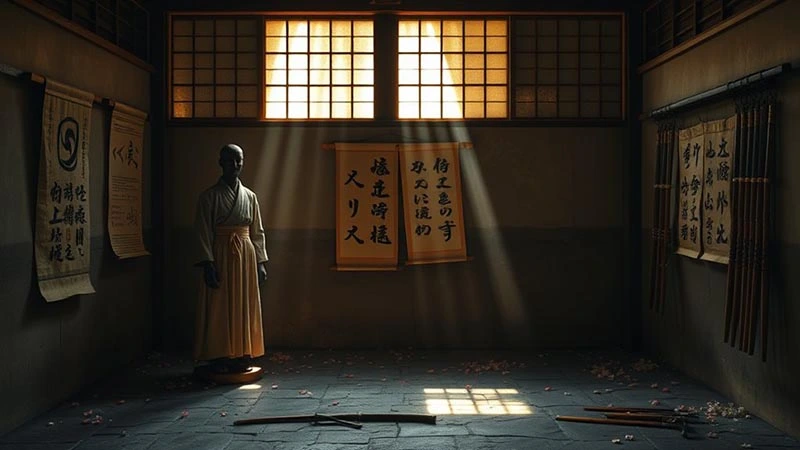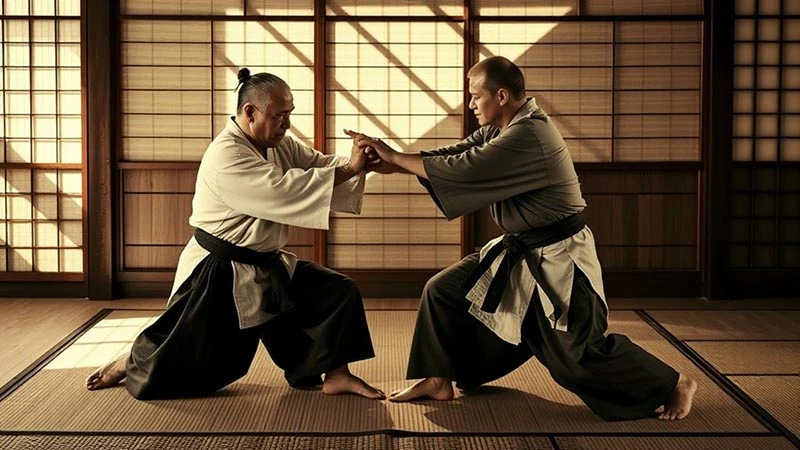Exploring the History of Aiki Jutsu and Atemi Jutsu
Aiki Jutsu and Atemi Jutsu emerged during Japan’s Sengoku period in the 1530s, developing from a blend of Chinese martial arts and local fighting traditions. These sophisticated combat systems were refined through the contributions of notable masters like Takenouchi Hisamori and the Minamoto family. Aiki Jutsu focuses on joint manipulation and throws, while Atemi Jutsu emphasises strategic strikes to vulnerable areas. Both arts evolved from battlefield techniques to comprehensive self-defence systems, incorporating philosophy alongside physical skills. The traditions continue to influence modern martial arts, with schools worldwide adapting these ancient practices for contemporary self-defence needs. Their rich history offers fascinating insights into Japanese martial culture.
Key Takeaways
- Aiki Jutsu and Atemi Jutsu emerged during Japan’s Sengoku period in 1532, with Takenouchi Hisamori combining various martial arts techniques.
- The Minamoto family, particularly Shinra Saburo Yoshimitsu, preserved and developed aiki techniques during feudal Japan.
- Buddhist monks introduced Chinese Kung Fu influences, which blended with local Japanese fighting practices to shape these martial arts.
- During the Edo period, schools shifted from purely combat-focused Bugei to Budo, emphasising personal development alongside fighting skills.
- Masters like Takeda Sokaku and Morihei Ueshiba refined these arts, leading to modern forms such as Aikido.
Origins of Japanese Combat Arts

While Chinese martial arts significantly influenced Japanese combat styles, Japan developed its unique martial traditions during the Heian period with the emergence of the samurai class. Buddhist monks played an essential role in bringing Chinese fighting methods, including kung fu, to Japanese shores, where these techniques blended with local fighting practices over centuries of refinement and adaptation.
During the pre-16th century era, Japan’s martial tradition focused on effective combat methods, including grappling, joint manipulation, and weapons training. The turbulent Sengoku period proved particularly significant, as it sparked the establishment of formal martial arts schools. These schools, especially those dedicated to Jiu-Jitsu, began emerging in the 1530s, each developing distinct approaches to combat. The Tokugawa shogunate later imposed strict regulations on dojos to maintain social stability.
The systematic development of Japanese martial arts reached new heights in the late 15th and early 16th centuries as schools integrated various techniques into structured curricula. Notable figures like Minamoto no Yoshimitsu, founder of Daitō-ryū Jujutsu, and later Takeda Sōkaku, helped establish the foundations of what would become influential arts like Aikijujutsu, marking Japan’s unique contribution to martial arts history.
Evolution Through Ancient Times

Throughout ancient Japan, the evolution of Aiki Jutsu and Atemi Jutsu occurred primarily during the Sengoku period, beginning with Takenouchi Hisamori’s groundbreaking combination of various martial arts in 1532. During this transformative era, warriors developed sophisticated techniques for close combat against armoured opponents, leading to the emergence of specialised schools like Kyushin Ryu, which focused on atemi-waza striking methods.
The Minamoto family, particularly through Shinra Saburo Yoshimitsu, played an essential role in developing and preserving aiki techniques. These methods were carefully guarded and passed down through generations, eventually forming the foundation of Daito-ryu Aiki-jujutsu. The art flourished during the Edo period (1600-1868) when various schools emerged and refined their approaches. The techniques were deeply rooted in feudal battlefield origins.
As Japanese martial arts evolved, Buddhist influences transformed combat techniques from purely practical methods into philosophical paths of self-development. This shift from Bugei to Budo emphasised the importance of personal growth alongside physical skill. The techniques expanded to include throwing, joint locks, and strategic approaches that used an attacker’s force against them, creating a comprehensive system of self-defence that valued both effectiveness and spiritual development.
Foundational Techniques and Principles

The foundation of Aiki Jutsu rests on precise joint manipulation techniques, which practitioners master through systematic training in shoden waza and related forms. These core methods work alongside strategic striking techniques known as atemi, which target specific pressure points to create openings and maintain tactical advantage during combat. By combining joint controls and carefully placed strikes, practitioners can effectively neutralise attacks while using an opponent’s force against them, making Aiki Jutsu a comprehensive defensive art. Maintaining proper ma ai during techniques is crucial for executing effective joint locks and strikes. By combining joint controls and carefully placed strikes, practitioners can effectively neutralise attacks while using an opponent’s force against them, making Aiki Jutsu a comprehensive defensive art.
Core Joint Manipulation Methods
Core joint manipulation methods in Aikido encompass three fundamental categories of techniques: Hiji Waza (elbow techniques), Tekubi Waza (wrist techniques), and the five basic teachings known collectively as “kyo” techniques. These methods form the backbone of Aikido’s defensive strategy, allowing practitioners to neutralise attacks while minimising harm to their opponents.
Within the Hiji Waza system, students learn essential elbow controls such as Hiji Garami (elbow wrap) and Ude-gaeshi (arm turn), which enable them to redirect an attacker’s force safely. The Tekubi Waza category includes powerful wrist techniques like Kote-gaeshi and Kote-hineri, providing effective responses to various attack scenarios. Mastering these techniques requires proper instructor guidance to ensure correct form and application. These movements flow naturally into the five progressive teachings, from Ikkyo through Gokyo, each building upon the previous lesson’s principles.
Joint manipulation in Aikido represents a sophisticated approach to self-defence, incorporating precise control through elbow, wrist, and arm locks. Through careful study of these methods, practitioners develop both technical skills and a deeper understanding of body mechanics, allowing them to protect themselves while respecting the well-being of others.
Essential Striking Target Points
Strategic striking points in Aiki and Atemi Jutsu target three major anatomical regions: the head, body, and back. Understanding these essential points enables practitioners to effectively neutralise threats while maintaining control over the intensity of their response. The strategic application of atemi strikes can create momentary openings for subsequent techniques or completely dissolve an attacker’s aggressive intent through precise targeting. Regular training in atemi techniques through kata style practice develops precision and control.
- Head region targets include the temples, bridge of the nose, and mastoid process, which can quickly disorient an opponent when struck with appropriate force.
- Body targets focus on areas like the solar plexus and kidneys, where strikes can temporarily immobilise without causing permanent damage.
- Back region strikes emphasise points between shoulder blades and along the spine, offering defensive options when facing rear attacks.
- Strategic application combines soft and hard power techniques to create joint locks or throw opportunities.
The sophisticated nature of atemi striking requires careful study of human anatomy and extensive practice to develop precision. These techniques form a significant component of the art, allowing practitioners to respond effectively while maintaining control over the encounter’s outcome through measured force application.
Start Your Martial Arts Journey Today
Masters Who Shaped The Arts

Throughout history, numerous influential masters have played pivotal roles in developing and preserving the arts of Aiki Jutsu and Atemi Jutsu. Among the most significant figures, Takeda Sokaku stands out for his instrumental role in teaching and popularising Daito-ryu Aiki Jujutsu. At the same time, Minamoto Yoshimitsu laid its foundation through his groundbreaking anatomical studies of battlefield casualties. His extensive travels across Japan helped him preserve and promote the art to thousands of students.
The legacy continued through remarkable individuals like Morihei Ueshiba, who studied under Takeda Sokaku before founding Aikido, and Kodo Horikawa, who helped preserve and transmit these ancient techniques. In the modern era, masters like Grandmaster Chenique established new branches, founding Atemi-Ryu Jujitsu in 1975 after extensive study of various martial arts.
The arts were further enriched by the contributions of Professor Moses Powell, who developed Vee-Jitsu ryu Jiujutsu, and Master Florendo Vistacion, who brought valuable insights to the system. These masters and contemporaries like Dr. Chenique have guaranteed that these powerful martial arts continue to evolve while maintaining their core principles and effectiveness.
Key Differences Between Styles

The fundamental differences between Aiki Jutsu and Atemi Jutsu lie in their distinct approaches to combat and self-defence. While Atemi Jutsu emphasises strategic strikes to essential points and vulnerable areas, Aiki Jutsu focuses on redirecting an attacker’s energy through joint manipulations and throwing techniques. These contrasting methods evolved from different historical needs, with Atemi developing to counter armoured opponents and Aiki emerging from traditional jujutsu principles. The influence of Mikonosuke Kawaishi helped shape modern Atemi Jujitsu’s technical framework for real-life combat situations.
The training methods between these arts also show significant variation, reflecting their philosophical differences. Atemi practitioners engage in intense randori and jiyu kumite, developing their striking abilities through dynamic practice. In contrast, Aiki Jutsu students progress through sequential learning, mastering the art of blending with and redirecting an opponent’s force.
- Atemi employs precise strikes to create openings and disrupt balance
- Aiki focuses on using the attacker’s own momentum against them
- Training intensity varies, with Atemi featuring more combat-oriented practice
- Both arts maintain traditional values while adapting to modern self-defence needs
Both styles maintain their effectiveness in practical self-defense scenarios, though they approach protection through different technical paths. Each offers unique advantages to practitioners seeking mastery in martial arts.
Modern Impact and Adaptations

Modern martial arts have been profoundly shaped by Aiki Jutsu and Atemi Jutsu, extending their influence beyond traditional Japanese dojos. These arts have evolved to meet contemporary needs while maintaining their core principles, mainly through the development of Aikido, which emerged from Daito-ryu Aiki-jujutsu. The integration of striking techniques (atemi-waza) and joint locks has created versatile systems that practitioners can adapt to various situations.
Training methods have also transformed to accommodate diverse practitioners. Modern dojos now combine traditional kata practice with dynamic randori sessions, allowing students to develop both precise technical skills and practical application abilities. This balanced approach has made these arts more accessible to people of all ages and physical capabilities while preserving their effectiveness. The emphasis on practical application has largely superseded traditional practice methods in many modern training environments.
The global spread of these martial arts has led to fascinating adaptations and innovations. International schools have emerged, each contributing unique perspectives to the arts’ evolution. Today’s practitioners benefit from this decadent fusion of traditional techniques and modern training approaches, creating martial arts systems that are both deeply rooted in history and remarkably relevant to contemporary self-defence needs.
Frequently Asked Questions
How Dangerous Are Aiki Jutsu Techniques When Practiced Without Proper Supervision?
Aiki Jutsu techniques can cause severe joint injuries, broken bones, and serious trauma when practised without supervision, especially during complex movements, joint manipulations, and weapon-based training exercises.
Can Women Effectively Learn and Master These Traditional Japanese Martial Arts?
Like a flowing river, strength knows no gender. Women excel in traditional Japanese martial arts through technical precision, leveraging flexibility and balance. These arts emphasise skill over brute force, making mastery equally attainable.
What Age Is Considered Appropriate to Begin Training in Aiki Jutsu?
Most practitioners can effectively begin Aiki Jutsu training between ages 10 and 14 when physical coordination and emotional maturity align. However, modified instruction can accommodate younger students with proper supervision.
How Long Does It Typically Take to Achieve Mastery in Atemi Jutsu?
Mastering Atemi Jutsu typically requires 10-20 years of dedicated training, with basic proficiency taking 5-10 years. Individual progress varies based on commitment, instruction quality, and natural aptitude.
Are There Any Religious or Spiritual Requirements to Practice These Arts?
No formal religious requirements exist for practising Atemi Jutsu or Aiki Jutsu, though many practitioners adopt spiritual elements for personal growth and mental development.
Final Thoughts
The rich traditions of Aiki jutsu and Atemi jutsu continue to influence modern martial arts training worldwide. A notable example occurred at the 2019 International Martial Arts Congress in Kyoto, where practitioners demonstrated how these ancient techniques effectively adapt to contemporary self-defence scenarios. As these arts evolve, their core principles of energy redirection and strategic striking remain relevant, proving that time-tested combat wisdom transcends generations while meeting today’s practical defence needs.

